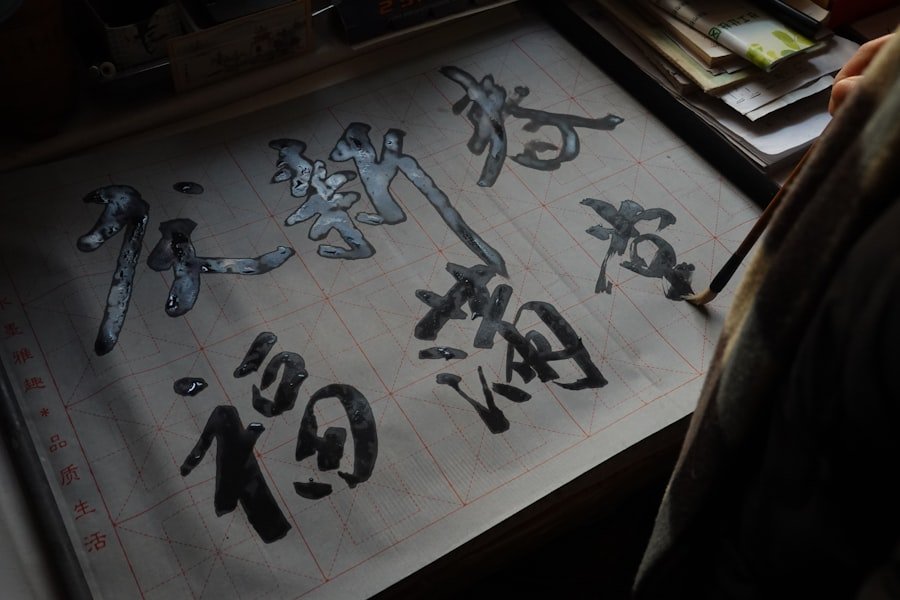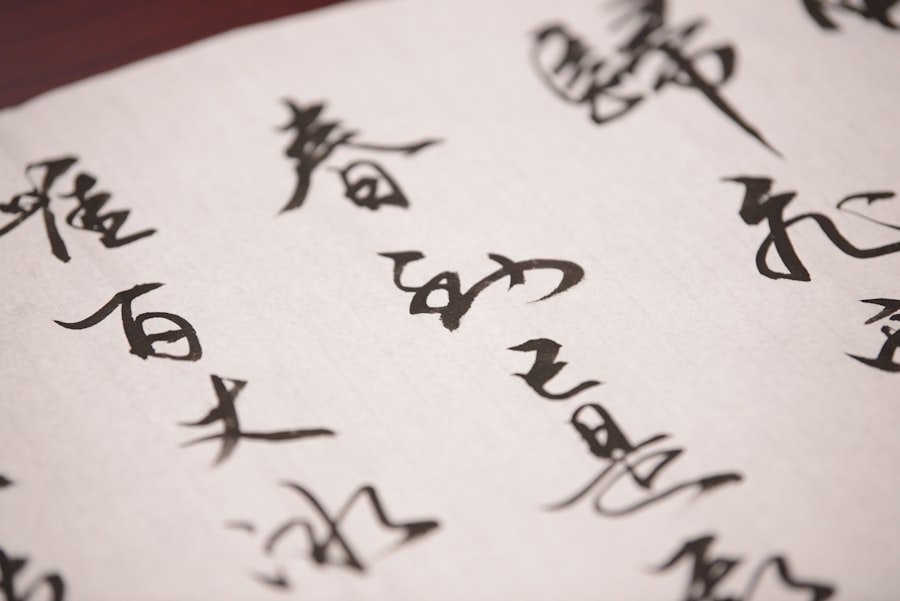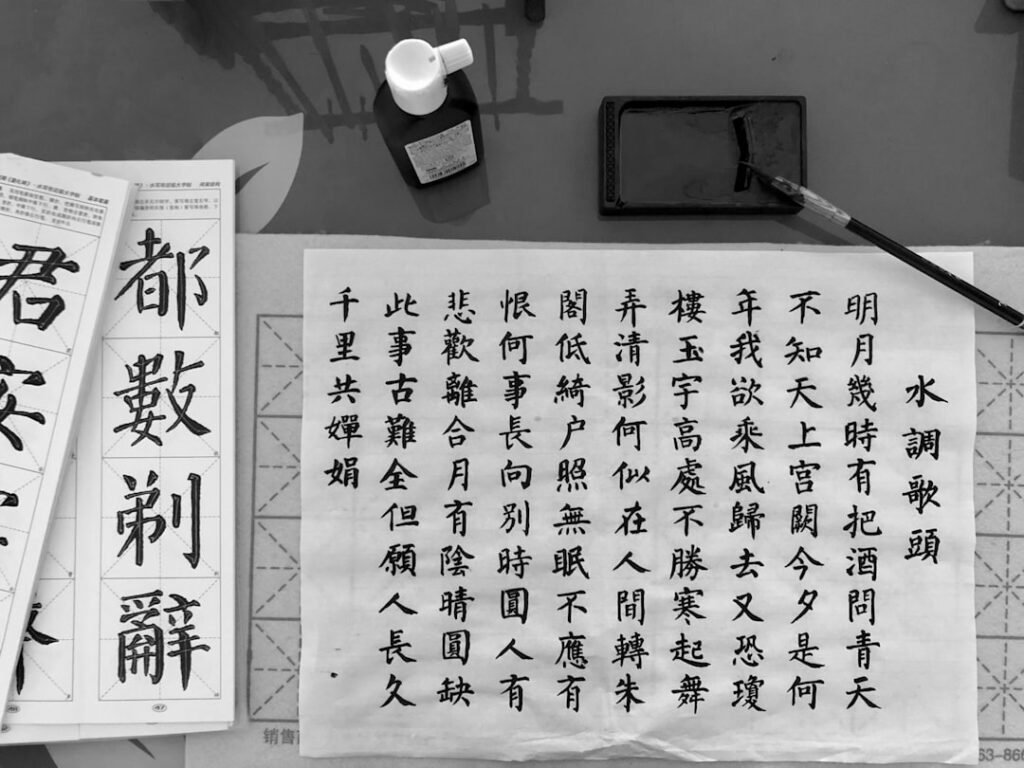Chinese calligraphy, an art form that has flourished for thousands of years, is deeply intertwined with the practice of signing one’s work. The history of signatures in Chinese calligraphy can be traced back to the Han Dynasty (206 BC – 220 AD), when artists began to inscribe their names on their works as a means of identification and authorship. This practice not only served to attribute the work to its creator but also reflected the artist’s personal style and philosophy.
Over time, signatures evolved from simple inscriptions to intricate designs that encapsulated the essence of the artist’s identity. During the Tang Dynasty (618–907 AD), the significance of signatures grew as calligraphy became a highly esteemed art form. Artists such as Wang Xizhi and Yan Zhenqing not only perfected their calligraphic techniques but also developed unique signature styles that became synonymous with their names.
These signatures were often seen as an extension of the artwork itself, embodying the spirit and intention behind the calligraphy. As the art form continued to evolve, so too did the complexity and artistry of signatures, leading to a rich tapestry of styles that would influence generations of calligraphers. Master the art of Chinese calligraphy. Enroll now at the LC Chinese School in Oslo.
Table of Contents
ToggleSummary
- Chinese calligraphy signatures have a rich history dating back to ancient times, with each dynasty contributing to the evolution of signature styles.
- Signatures in Chinese calligraphy are highly valued as they represent the artist’s identity, skill, and personal expression, and are considered an integral part of the artwork.
- Various techniques and styles are used in signing Chinese calligraphy, including the use of different brushes, ink, and paper, as well as the incorporation of personal seals and stamps.
- Seals are commonly used in Chinese calligraphy signatures to add a sense of authority and authenticity to the artwork, and are often passed down through generations.
- Famous masters of Chinese calligraphy have developed unique signature styles that reflect their individuality and artistic prowess, influencing the evolution of signature styles over time.
The Importance of Signatures in Chinese Calligraphy
In Chinese calligraphy, signatures hold immense importance, serving as a bridge between the artist and the viewer. They are not merely a name scrawled at the bottom of a piece; rather, they encapsulate the artist’s identity, philosophy, and emotional state at the time of creation. A signature can convey a sense of authenticity and legitimacy, allowing viewers to connect with the artist on a deeper level.
This connection is particularly significant in a culture that places great value on lineage and tradition, where an artist’s reputation can be closely tied to their signature. Moreover, signatures in Chinese calligraphy are often seen as a form of artistic expression in their own right. The style, size, and placement of a signature can enhance the overall composition of a piece, adding an additional layer of meaning.
For many artists, their signature is a reflection of their journey and growth as a calligrapher, evolving alongside their skills and experiences. Thus, signatures are not only a means of identification but also an integral part of the artwork itself, contributing to its aesthetic and emotional resonance.
Techniques and Styles of Signing in Chinese Calligraphy

The techniques employed in signing Chinese calligraphy are as varied as the styles themselves. Traditionally, artists would use a brush dipped in ink to create their signatures, allowing for fluidity and expression that reflects their individual style. The brushwork involved in signing can range from bold strokes to delicate flourishes, each choice conveying different emotions and intentions.
Some artists may opt for a more traditional approach, adhering to established styles, while others may experiment with contemporary techniques to create a signature that is uniquely their own. In terms of styles, there are several prominent forms that have emerged throughout history. The “Regular Script” (Kai Shu) is one of the most widely used styles for signatures due to its clarity and legibility.
In contrast, the “Running Script” (Xing Shu) offers a more fluid and dynamic appearance, often favoured by artists seeking to convey movement and energy in their work. Additionally, some calligraphers may choose to incorporate elements from other styles, such as “Cursive Script” (Cao Shu), which allows for greater spontaneity and expressiveness. Ultimately, the choice of technique and style is deeply personal, reflecting the artist’s character and artistic vision.
The Use of Seals in Chinese Calligraphy Signatures
Seals play a crucial role in the realm of Chinese calligraphy signatures, serving as both a mark of authenticity and a decorative element that enhances the overall composition. Traditionally carved from stone or wood, these seals are stamped onto artworks alongside or instead of signatures, providing an additional layer of identification for the artist. The use of seals dates back to ancient China when they were employed for official documents and personal correspondence.
Over time, they became an integral part of the artistic process in calligraphy. The design of a seal is often unique to the artist and can include their name, studio name, or even auspicious symbols that reflect their personal beliefs or aspirations. The act of stamping a seal onto a piece is considered a significant moment in the creation process, akin to signing one’s name.
It signifies completion and adds an element of finality to the work. Furthermore, seals can enhance the visual appeal of a piece, providing contrast against the flowing lines of calligraphy. As such, they are not merely functional but also serve as an artistic embellishment that enriches the overall aesthetic experience.
Famous Masters and Their Signature Styles
Throughout history, numerous masters have left an indelible mark on the world of Chinese calligraphy with their distinctive signature styles. One such figure is Wang Xizhi, often revered as the “Sage of Calligraphy.” His signature is characterised by its elegance and fluidity, embodying the principles of balance and harmony that define his work. Wang’s approach to signing was deeply influenced by his philosophical beliefs, which emphasised spontaneity and naturalness.
Another notable master is Yan Zhenqing, whose signature style is marked by its boldness and strength. Yan’s work reflects his military background and his commitment to Confucian ideals. His signatures often feature strong strokes that convey authority and confidence, making them instantly recognisable.
These masters not only shaped their own signature styles but also influenced countless generations of calligraphers who sought to emulate their techniques while infusing their own individuality into their work.
The Evolution of Signature Styles in Chinese Calligraphy

The evolution of signature styles in Chinese calligraphy mirrors broader cultural shifts and artistic movements throughout history. In ancient times, signatures were often simple inscriptions that served primarily functional purposes. However, as calligraphy gained prominence as an art form during the Tang and Song Dynasties (960–1279 AD), signatures began to take on greater significance as expressions of personal identity and artistic intent.
The Ming Dynasty (1368–1644 AD) marked a turning point in this evolution, as artists began to experiment with more elaborate signature styles that incorporated elements from various calligraphic traditions. This period saw a flourishing of creativity, with artists drawing inspiration from both classical texts and contemporary influences. As modernity approached in the Qing Dynasty (1644–1912 AD), signatures became increasingly diverse, reflecting individualism and personal expression rather than adherence to established norms.
The Symbolism and Meaning Behind Chinese Calligraphy Signatures
Chinese calligraphy signatures are imbued with rich symbolism and meaning that extend beyond mere identification. Each stroke in a signature can represent various concepts such as strength, grace, or wisdom, depending on the artist’s intention and style. For instance, a bold signature may convey confidence and assertiveness, while a more delicate one might suggest introspection or sensitivity.
Moreover, many artists incorporate auspicious symbols or characters into their signatures that reflect their hopes or aspirations for success and prosperity. This practice underscores the belief that art is not only a visual experience but also a spiritual one that connects the artist with deeper cultural narratives. As such, signatures become vessels for conveying personal philosophies and cultural values that resonate with viewers on multiple levels.
The Influence of Chinese Calligraphy Signatures on Modern Art
The influence of Chinese calligraphy signatures extends far beyond traditional practices; they have permeated modern art movements both within China and internationally. Contemporary artists often draw inspiration from traditional calligraphic techniques while infusing them with modern sensibilities. This fusion creates a dialogue between past and present, allowing for innovative expressions that challenge conventional boundaries.
In recent years, there has been a resurgence of interest in traditional calligraphy among modern artists who seek to explore its relevance in contemporary contexts. Many have adopted signature styles as a means of asserting their identity within an increasingly globalised art world. By incorporating elements of traditional calligraphy into their work, these artists pay homage to their cultural heritage while simultaneously pushing the boundaries of artistic expression.
The Role of Signatures in Authenticating Chinese Calligraphy Works
In the realm of Chinese calligraphy, signatures play a pivotal role in authenticating works and establishing provenance. Given the high value placed on original pieces by collectors and connoisseurs alike, verifying an artist’s signature is essential for determining authenticity. Experts often rely on stylistic analysis and historical context to assess whether a signature aligns with known examples from an artist’s oeuvre.
Furthermore, signatures can provide insights into an artwork’s history and significance within broader cultural narratives. For instance, understanding an artist’s signature style can reveal connections between different periods or movements within Chinese art history. As such, signatures serve not only as markers of authorship but also as keys to unlocking deeper understandings of artistic lineage and cultural heritage.
Tips for Creating a Unique and Personal Signature in Chinese Calligraphy
For those interested in developing their own unique signature in Chinese calligraphy, several tips can help guide this creative process. Firstly, it is essential to explore various styles and techniques to find what resonates most with your artistic sensibilities. Experimenting with different brush strokes and ink applications can lead to discoveries about your personal style that may inform your signature.
Additionally, consider incorporating elements that reflect your identity or values into your signature design. This could include auspicious symbols or characters that hold personal significance or even stylistic choices that convey specific emotions or philosophies. Ultimately, creating a signature should be an introspective process that allows you to express your individuality while honouring the rich traditions of Chinese calligraphy.
The Future of Chinese Calligraphy Signatures in the Digital Age
As we navigate an increasingly digital world, the future of Chinese calligraphy signatures faces both challenges and opportunities. While traditional practices may be at risk of being overshadowed by digital mediums, there is also potential for innovation within this space. Digital tools offer new avenues for artists to experiment with calligraphic techniques while reaching wider audiences through online platforms.
Moreover, there is growing interest in preserving traditional practices through digital archiving initiatives that document historical signatures alongside contemporary interpretations. This fusion of tradition and technology could pave the way for new forms of expression that honour the past while embracing modernity. For those eager to delve deeper into this captivating art form, LC Chinese School in Oslo offers specialised courses in Chinese calligraphy that encompass both traditional techniques and contemporary approaches.
These courses provide students with hands-on experience under expert guidance while fostering an appreciation for the cultural significance behind each stroke—an ideal opportunity for anyone looking to explore their creativity through this timeless art form. Whether you are a beginner or seeking to refine your skills further, LC Chinese School serves as an excellent platform for nurturing your passion for Chinese calligraphy signatures amidst Oslo’s vibrant cultural landscape.
Master the art of Chinese calligraphy. Enroll now at the LC Chinese School in Oslo.







